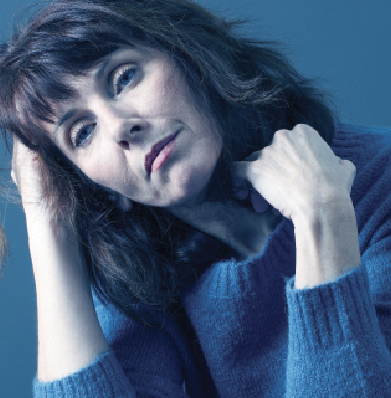
Got The Winter Blues?
By: Jessica Park
After the excitement of the holidays is over, it’s normal to feel underwhelmed returning to the daily grind, especially with several months of cold winter weather ahead of us. But some people feel more than a post-holiday letdown. For people with Seasonal Affective Disorder (SAD), the change of seasons brings a change of mood.
SAD typically affects adults and usually starts in the fall and winter months, when exposure to natural daylight is decreased. People living further north, where days are shorter during winter, are more likely to experience SAD — in Florida, 1.4 percent of the population has been diagnosed with SAD, while in New Hampshire, the rate is 9.7 percent.
“According to the American Academy of Family Physicians, about 4 to 6 percent of the overall population in the United States experiences fall and winter SAD, and 10-20 percent of the population may experience mild SAD. This is a significant number of people,” explains Rob McGavock, MEd, LPC, a licensed professional counselor with Boone Hospital Center’s Employee Assistance Program.
McGavock adds that SAD affects women more often than men. Some people experience a less common form of SAD that starts in spring and summer months. Seasonal changes can also trigger manic episodes in some people with bipolar disorder.
What causes SAD?
Changes of exposure to daylight hours cause fluctuations of melatonin, a hormone produced in the brain that regulates your sleep cycle and internal clock. Most people feel this effect in fall and winter and suffer with symptoms of clinical depression due to the changes.
Even though Seasonal Affective Disorder is commonly called SAD, depression isn’t the same thing as sadness. Depression is a complex medical condition with many possible causes that trigger physical and emotional symptoms.
Symptoms of Seasonal Affective Disorder:
Sleep problems:
You sleep more than usual and have difficulty waking up in the morning.
Loss of energy:
You feel fatigued. Your arms and legs feel heavier.
Feeling depressed:
You feel generally unhappy without any external cause, or you feel “flat.”
Feelings of hopelessness:
You feel pessimistic about the future or feel like “everything is pointless.”
Increased irritability: You’re more irritable and more easily upset. You cry more easily and frequently. You have increased feelings of anxiety.
Impaired function: You find it harder to concentrate. Everyday tasks feel very difficult and take you longer to complete.
Appetite changes:
Your appetite has increased and you have gained weight. You crave foods with a lot of carbohydrates. You overeat to try to feel better.
Lower sex drive:
You lose normal interest in intimacy with your partner.
Social withdrawal:
You feel like being alone more than usual. You avoid going out with family or friends.
Lack of pleasure:
You lose interest in doing the things that you used to enjoy. You no longer look forward to doing your favorite activities. It feels difficult to have fun or enjoy life.
Self-medicating:
You may try to make yourself feel better by overeating, drinking alcohol or abusing drugs.
Suicidal thoughts or feelings:
You feel hopeless and have thoughts that life is too hard to want to live. Seek help immediately. “You should go to the emergency department or call 911 if suicide feels like an option to you,” McGavock advises. “It’s always best to be safe.”
People who experience SAD in spring and summer months may have some different symptoms. They usually sleep less than usual, have a decreased appetite and an increased sex drive.
Treatment Options:
If you’ve been experiencing symptoms of depression for a few weeks, see your doctor. Your doctor can determine if your depression is caused by Seasonal Affective Disorder or any other type of depression, and discuss which treatment options are right for you. There are several effective options for managing SAD.
Light Therapy: Light therapy is a proven treatment for relieving symptoms of SAD. In the morning, you sit for about 30 minutes near a light box, a full-spectrum lamp that mimics bright sunlight. Dawn simulators, alarm clocks that use gradually brightening light to wake you up, are another light therapy option. You can find light boxes and dawn simulators in stores and online, with a wide range of features and prices. Before buying a light therapy device, ask your doctor for recommendations.
Medication: Your doctor may recommend taking a prescription antidepressant during fall and winter months. Some patients find relief from symptoms of SAD with prescription medications that are usually used for some sleep disorders, such as for narcolepsy.
Therapy: Talking to a mental health professional can help you cope with the symptoms of SAD, learn how to manage stress, and help to change any behaviors and thoughts that are making you feel worse.
Healthy Habits: You may not feel like exercising when depressed, but regular exercise, especially outdoor exercise, is good for people with Seasonal Affective Disorder. Take a brisk walk outside on a sunny day! Maintain a regular sleep schedule and eat a healthy, balanced diet.
Other Treatments: Other treatments for SAD are currently being researched and tested, such as ionized air administration or ear canal light therapy.
“Recently it’s been discovered that brain tissue cells in the ear canal are highly light sensitive. A study in Finland found that ear canal light treatments decreased depression quite significantly,” McGavock says. The 2014 study participants received 12-minute-long treatment sessions every day for three weeks.
Don’t suffer needlessly: No matter what season it is, don’t be afraid or embarrassed to get help if you’ve been feeling depressed. You’re not “weak” or “crazy.” You can’t force yourself to “snap out” of a mood disorder any more than you can snap out of the flu. Remember that you deserve to feel your best and that there are people who can and want to help you.
“There’s no need to suffer with Seasonal Affective Disorder,” McGavock says. “It’s a medical issue, not a character defect or a psychological problem.”